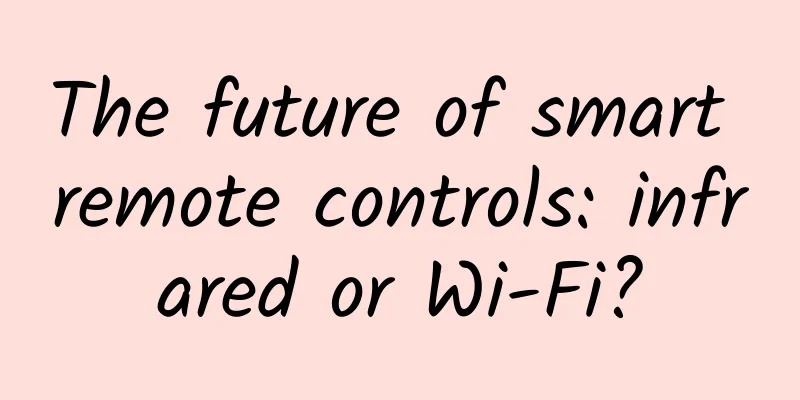The future of smart remote controls: infrared or Wi-Fi?

|
Recently, according to media reports, Alibaba has once again invested 50 million US dollars in the smart remote control application Peel. It is not difficult to see that industry giant Alibaba is laying out the field of smart home appliances, and the smart TV products that Peel focuses on are currently the fastest-growing industry branch with constant news. Peel's remote control mechanism is realized through infrared technology on smartphones. With the corresponding application, you can use mobile devices such as mobile phones to remotely control most TVs, set-top boxes and other smart home appliances. Products such as mobile phone remote control not only provide a new way of interaction, but also make it easy to control the entrance and exit of the TV screen. At present, the forms of smart TV remote controls on the domestic market are mainly divided into two categories: those based on infrared technology similar to Peel and those based on Wi-Fi remote control. In terms of use, the two also have different characteristics. Infrared remote control: convenient but limited Compared with technologies such as Bluetooth, infrared does not require pairing and is easy to control. Infrared remote control applications currently available in major app stores can control home appliances such as TVs, set-top boxes, DVDs, and air conditioners. Convenience and high compatibility are one of the advantages of infrared. In terms of functions, the infrared remote control basically simulates the traditional remote control in the smartphone, realizing basic functions such as channel switching, volume increase and decrease, and TV on and off on the TV. In addition to the basic remote control function, Peel has added an introduction to TV programs and the ability to quickly open channels from this page, which is also an important feature compared to other products. However, the user experience of using a mobile phone with touch control is not better than that of a physical remote control, as it is just a remote control function. In addition, there are relatively few mobile phones with infrared functions in China. For manufacturers, adding infrared functions requires reserving external interfaces during industrial design, and circuit boards and internal space also need to be designed, which increases development costs. From a technical point of view, infrared technology lags behind Bluetooth technology and WiFi, with low transmission rates and short distances. For most smartphones, there is no need to install it. For example, searching for mobile phones with infrared functions on the Internet mainly focuses on Samsung, HTC, LG, Sony and other brands, with less than 100 products. In addition, the "alignment" problem with the receiving device that we encounter when using traditional remote controls is also the same for infrared smart remote controls. Overall, if we put aside the additional services provided by Peel, smart remote controls based on infrared technology are, to be precise, a variant of traditional remote controls on smart mobile devices. Wi-Fi Remote Control: More functionality with software The main producers of Wi-Fi remote control applications are box manufacturers such as Alibaba TV Assistant, Xiaomi Remote Control, LeTV Box Assistant, or third-party software companies such as Wukong Remote Control and 360 TV Assistant. Using Wi-Fi remote control requires that the smartphone and smart TV are in the same wireless network environment, which is a hard threshold. For home appliances other than smart TVs, it is necessary to wait until the Wi-Fi function is fully popularized before the basic conditions for connecting with the Wi-Fi remote control are met. Of course, in the case of Wi-Fi, users can remotely control the device via their mobile phone without having to "aim". This means that we can control the TV in the living room from the bedroom, and the data processing response of the Wi-Fi local area network is fast enough, faster than the common Bluetooth connection, so there is no need to worry about delays. On the other hand, most smart TVs on the market are equipped with systems developed based on Android. They are similar to enlarged tablets or mobile phones. Through the functional design of the remote control App, not only the basic functions of operating the TV are realized, but also more applications can be installed for the smart TV, similar to the application store on the mobile phone. Although there are a large number of TV application markets, it is relatively cumbersome to use the arrow keys on the remote control to select or find applications. In contrast, the Wi-Fi remote control can have a built-in application store on the mobile device, and install and update TV applications through the mobile phone. The operation similar to that of a smartphone makes it easier for users to quickly start and uninstall TV applications on their mobile phones. In addition, based on the Android system, the Wi-Fi remote control can also realize more abundant functions. Take the Wukong remote control as an example. It provides four different remote control modes. In gesture mode, sliding your finger on the screen can simulate the direction keys, and no longer requires corresponding keys. The mouse mode is similar to a wireless mouse, which makes it easier to select and click content when browsing the web on TV. Users can also use voice control to speak commands to open applications and TV programs. With the help of wireless networks, Wi-Fi remote controls can achieve more functions beyond remote control operations, becoming a tool application for smart TVs. The current Wi-Fi remote control software can already detect the network speed, storage space, and memory of smart TVs, and can optimize performance. Families with children can use child locks to set time to prevent children from watching TV too much. In terms of entertainment and audio-visual, the remote control can be turned into a game controller to play TV games, or it can be used as a companion to a TV video application to search and start the TV programs you want to watch. In short, Wi-Fi remote controls provide more diversified product thinking. Infrared or Wi-Fi? As for which type of remote control application users choose, they may come up with different answers based on their own devices and needs. However, after the traditional infrared transmission method, the popularity of Wi-Fi has allowed us to see a new model of smart remote control. The future of remote control will definitely move forward in the direction of being more user-friendly, more intelligent, and integrating more functions. As a winner of Toutiao's Qingyun Plan and Baijiahao's Bai+ Plan, the 2019 Baidu Digital Author of the Year, the Baijiahao's Most Popular Author in the Technology Field, the 2019 Sogou Technology and Culture Author, and the 2021 Baijiahao Quarterly Influential Creator, he has won many awards, including the 2013 Sohu Best Industry Media Person, the 2015 China New Media Entrepreneurship Competition Beijing Third Place, the 2015 Guangmang Experience Award, the 2015 China New Media Entrepreneurship Competition Finals Third Place, and the 2018 Baidu Dynamic Annual Powerful Celebrity. |
>>: Will anonymous group chat become the next social hotspot?
Recommend
Huawei AppGallery keyword search bidding advertising is now online!
Huawei AppGallery launched the "Search Keywo...
I heard that eating cassava can help you sleep? Don’t! Be careful of poisoning!
"Cassava helps you sleep. You can sleep for ...
What you need to know about adaptation - MobileWeb adaptation summary
Straight to the point, this article will summariz...
Three steps to launch the event!
Event operation is different from content operati...
A thousand days of rescue! Who is the owner of Wuwangdun Tomb No. 1?
A 1.92-meter-high drum stand with a phoenix-shape...
What are the functions of the Tea Mall Mini Program? How much does it cost to develop a Tea Price Mini Program?
The tea drinking culture has a long history in my ...
In memory of the 2022 Republic, 17 academicians have been lost
This year 17 academicians have passed away Commem...
Huawei AppGallery Brand Resource Bidding Promotion Service Rules
These rules are based on the Huawei Developer Ser...
Waymo to bring driverless cars to Detroit Auto Show
According to foreign media reports recently, Waym...
How much does it cost to outsource WeChat mini programs? What does the price of outsourcing WeChat Mini Program development include?
How much does it cost to outsource WeChat mini pr...
All things are difficult at the beginning. How do website operators find “seed users”?
After you have identified your target users in we...
Don't squeeze a pinhole! Here's how to deal with it correctly
Eyes are the windows to the soul and one of the m...
Lithium batteries are not the way to go. Japanese and Korean companies say hydrogen fuel is the future of new energy vehicles?
The emergence of iOS and Android phones completel...
How to make money with WeChat public account? Free sharing of tutorials on how to make money with public accounts
How soon can you make money? After watching the v...
The Yotaphone 2 Putin gave to Xi Jinping has a built-in Chinese chip technology SlimPort
Beijing, China – Analogix® Semiconductor, a marke...









